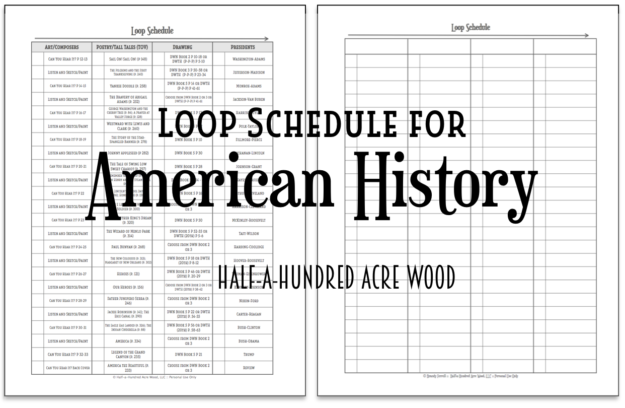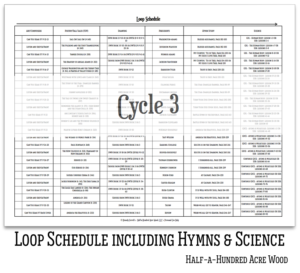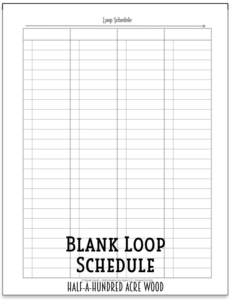It dawned on me this week that I didn’t really talk about our loop schedule when I posted our American History Plans! Since this is the one terrific tool that keeps the good, true, and beautiful in our schedule, I thought I’d mention it in greater detail.
Our loop schedule has been greatly simplified for the coming year. The goal is to easily incorporate art study, music appreciation, drawing, and poetry into our school days during our morning time along with our daily geography practice (from Draw the USA) and our daily science-wonder activity from Jay Wile’s Science in the Scientific Revolution (which is such a great and simple way to study science over time – and with a Biblical worldview!) The books referenced in our loop schedule are….
But wait a minute! What’s a loop schedule?
Loop scheduling is just a way of planning. In a loop schedule, you cycle through subjects in a loop instead of doing them on a certain day each week. For example, in a normal block schedule, I can set aside Wednesday afternoons for nature study, Thursday afternoons for composer study, and Friday afternoons for art projects. But… if our schedule is interrupted due to unforeseen circumstances, we will either totally miss what we planned to do for a particular subject that week or have to double up the next week to “catch up.”
If I use a poetry-composer study-art loop schedule, we can cycle through those tasks without worrying about totally missing out on Art Friday, for example. If we don’t get around to art on Friday, we’ll just do it on Monday. Even though I put together a reading plan with assigned tasks for poetry, composer study, and art study each week, we often fall “behind schedule” because of things like illness, drama rehearsals, field trips, serious potty-training mishaps, or Distractible Mom Syndrome. In this case, we just pick up where we left off the next day and don’t worry about not getting it finished on a particular day. So… while I offer weekly plans, a loop schedule more accurately represents what we do. And even though it’s not listed as a loop, we also handle our read aloud books (in the Family Read Aloud section of our reading plans) in much the same way. The image below shows a daily reading plan for two weeks written into a weekly planner vs what it looks like if you simply write these onto a separate page as a loop schedule.
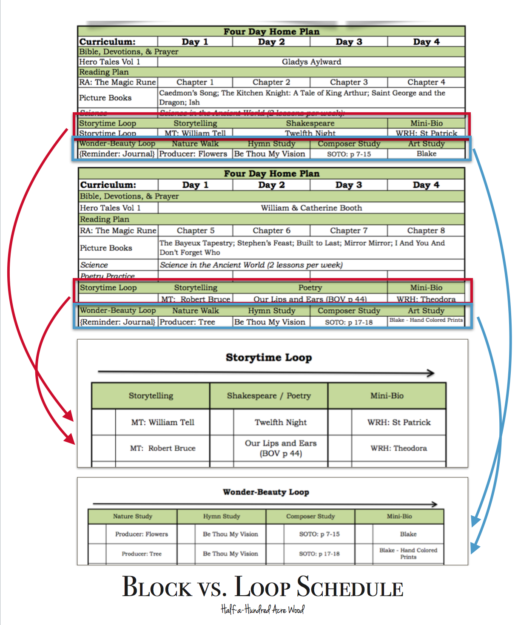
If you compare the loop schedules at the bottom of the image to the reading plan above it, you’ll see that it goes in the same order. If this is still clear as mud, or if you have additional questions about loop scheduling, please let me know!
Our Loop Schedule.
(art, music appreciation, storytelling, drawing, Presidents; For an explanation of why we chose these books, visit this post.)
Like I was saying, our loop schedule has been greatly simplified for the coming year (as in, we only have one loop this time and it’s an easy one). The goal is to easily incorporate art study, music appreciation, drawing, and poetry into our school days during our morning time, along with our daily geography practice (from Draw the USA) and our daily science-wonder activity from Jay Wile’s Science in the Scientific Revolution (such a great and simple way to study science through the ages with a Biblical worldview!)
The books referenced in the loop schedule are:
- Can You Hear It? by William Lach. Great book with a CD for music appreciation and art study prompts. Great combo book that will help you easily incorporate music and art appreciation into your days! Students will study each music/artwork combo in this book for two weeks. The second week they will listen to the audio again while sketching the image as they listen to the music or attempting to imitate the painting style/technique used in the artwork. For example, the first music/artwork combo is “Flight of the Bumblebee” and Chrysantheums. The second week, the student attempts to imitate the artwork either by sketching, practicing upside-down drawing, or actually painting using a similar style and medium.
- William Bennett’s Children’s Treasury of Virtues. (Listed as TOV in the Loop Schedule.) I love, love, love this book! It includes poetry, tall tales, heroic biographical stories, and even a few hymns! The Children’s Treasury of Virtues is a three-part book that includes Bennett’s earlier individual works aimed at young children: The Children’s Book of Virtues, The Children’s Book of Heroes, and The Children’s Book of America. Our reading plan calls mainly upon reading selections from The Children’s Book of America. So, if the price skyrockets, search for each of the individual works (or just search for the Book of America to have the majority of the readings which correlate with U.S. History). Read more about this book and see pictures of the inside here. You can also download the reading correlations for Book of Virtues.
- Draw Write Now (Book 2, Book 3, and Book 5) (listed as DWN in the Loop Schedule), or Draw and Write Through History (Pilgrims, Pirates, and Patriots and The 20th Century) (listed as DWTH in the Loop Schedule.) Developing drawing skills will greatly assist our students when they get to Challenge A. Draw Write Now is best for children in grades PreK through 4 (although some older students could benefit), and Draw and Write Through History is good for grades 3 through 12). Also be sure to download FREE Draw Write Now Printables here!
- Presidential Pets: The Weird, Wacky, Little, Big, Scary, Strange Animals That Have Lived In The White House or Don’t Know Much About the Presidents. We love the funny little poems that go with Presidential Pets. It’s a great way to enjoy the rhythm of poetry while also learning a bit about each U.S. President! Don’t Know Much about the Presidents is another fun book about the Presidents that would work well with students up to middle school age. Choose either of these or use any other book about Presidents that you have on hand.
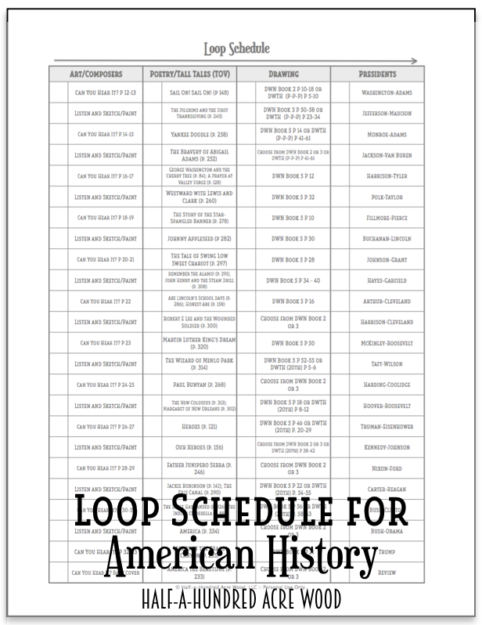 Download our loop plan here.
Download our loop plan here.
This American History Loop Schedule is included in our American History Reading Plans, which also includes topical booklists for additional picture books, read alouds, leveled readers, Who Was… books, Magic Tree House, and Imagination Station. Check out all the details here.
Explanation. The way this works is…
You start with row one, column one and work across the table until you complete each row. If we start the loop schedule on Week 1:
- Monday – Listen to Can You Hear It? p12-13 and study artwork (for art and music study)
- Tuesday – Whoops! We had a dentist appointment and didn’t get around to our full school day.
- Wednesday – Pick back up with your schedule and read “Sail On! Sail On!” (p 148) in William Bennett’s Treasury of Virtues.
- Thursday – Practice drawing from Draw Write Now Book 2 p10-18 or Draw & Write Through History (Pilgrims, Pirates, and Patriots) p5-10
- Friday – Community day, so we won’t be doing school at home.
Week 2:
- Monday – Pick up where you left off and continue with reading about Washington-Adams from Presidential Pets.
- Tuesday – We’re back to Can You Hear It? (row 2, column 1) and will re-study and listen to the same music as last week as we attempt to sketch or paint whatever is in the painting
- Wednesday – Read the selection (“The Pilgrims and the First Thanksgiving”) from William Bennett’s Treasury of Virtues.
- …and so on.
As you work across the table completing each activity, just check the box to keep up with where you are.
It’s structured so that if you’re using the 4-subject loop, you can probably get through Art/Composers, Poetry/Tall Tales, Drawing, and Presidents each week, but you’re not tied to it being done within the week because you’re using a loop instead of a weekly planner.
Another loop schedule option.
For those who wish to include hymns and science in the loop schedule (instead of having them incorporated into your daily routine), I’ve created a separate loop schedule including hymns and science. Download it here. (Note that this is not the loop plan we’re following because science and hymns are daily activities for us. The abbreviations for science are SSR: Science in the Scientific Revolution, God’s Design for Life: The Human Body, and GDCE: God’s Design for Chemistry & Ecology: Atoms & Molecules.)
This American History Loop Schedule is included in our American History Reading Plans, which also includes topical booklists for additional picture books, read alouds, leveled readers, Who Was… books, Magic Tree House, and Imagination Station. Check out all the details here.
Each hymn in the list below is amazon-affiliate-linked to an audio recording of the hymn as recorded by contemporary Christian music artists (except SHeDaisy, which I think is a country music group). Our family uses a hymn playlist that we’ve loaded onto a Sonos system for our daily Morning Wake-Up Call. The hymns we’re becoming familiar with this year are:
- Blessed Assurance (by Matthew West on album Jesus, Firm Foundation)
- My Country ‘Tis of Thee (by PraiseCharts) or My Jesus I Love Thee (by Casting Crowns on album Glorious Day: Hymns of Faith)
- Trust & Obey (by Big Daddy Weave on album Every Time I Breathe)
- The Star-Spangled Banner (by Praisecharts)
- Turn Your Eyes Upon Jesus (by Nicole Nordeman on album Jesus, Firm Foundation)
- Battle Hymn of the Republic (by SHeDaisy)
- America the Beautiful (by Praisecharts)
- His Eye is on the Sparrow (by Newboys on album Hallelujah for the Cross)
- I Surrender All (by Casting Crowns on album Glorious Day: Hymns of Faith)
- At Calvary (by Casting Crowns on album Glorious Day: Hymns of Faith)
- It Is Well with My Soul (by Jeremy Camp and Adie Camp on album Music Inspired By The Motion Picture Amazing Grace)
- When We All Get to Heaven (by Casting Crowns on album Glorious Day: Hymns of Faith)
The pages referenced in the loop schedule are for Then Sings My Soul, which includes a hymnal page along with a historical reference and related scripture.
The science lessons referenced are for Jay Wile’s Science in the Scientific Revolution or God’s Design for Life: The Human Body and God’s Design for Chemistry & Ecology: Atoms & Molecules. These are just two options for science. You can also refer to our American History Reading Plans for other options. Let me just mention here that going through multiple science lessons in a day (as shown in this loop schedule) is not usually a very good way to study science. You may opt to just go on nature walks instead of using a science book, and that’s great! Our children have asked for more science investigations, and Science in the Scientific Revolution provides us with opportunities to explore many different aspects of science in an engaging way.
You can take a look at what this loop schedule has looked like in action on this post.
Finally, if you’d like to create your own loop schedule, download a blank one. PDF | XLS
I think that’s all you need to go a little loopy in the coming year. If you have any questions, just give us a shout!

